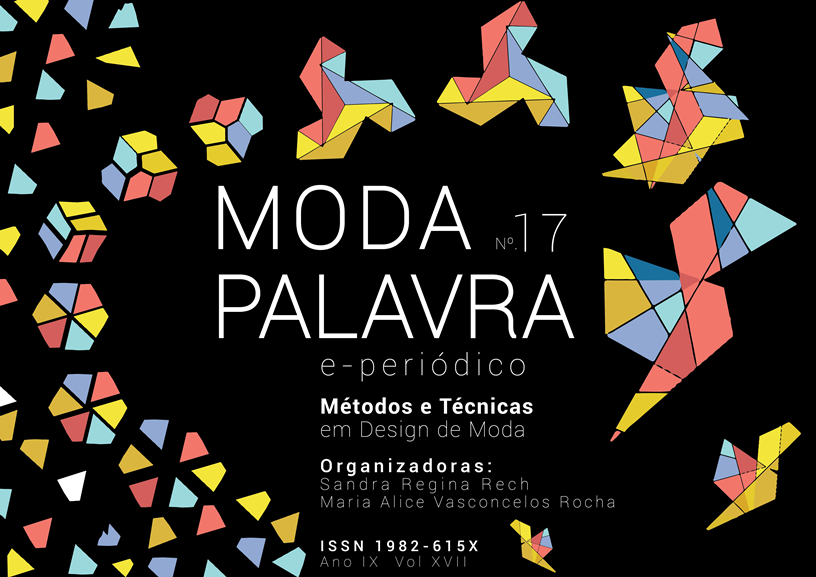Consumers, Designers and Managers: application of means-end chain model for fashion-clothing product development
DOI:
https://doi.org/10.5965/1982615x09172016048Keywords:
design management, research methods, garmentAbstract
The main aim of this study is to find a methodological tool able to support product development decision-making teams. The approach considers three main stakeholders: consumers, designers and companies. Qualitative and quantitative analyses were carried out based on primary data gathered in the UK, Brazil and China. The Gutman’s Means-End Chain Model (1982), comprised of Attributes, Consequences and Values, was used for the analyses. The results demonstrate that designers and companies are far from achieving synergy with consumers. The Means-End Model blending stakeholder interests seems to be an effective tool to support the decision-making process in fashion-clothing design.
Downloads
References
BRANCO, J.; PROVIDÊNCIA, F.; PINTO, C. &BRANCO, V. Design research for small and medium-sized enterprises. Milan, Italy: Design plus Research(D+R e-journal), v. 1, 2000. http://pcsiwa12.rett.polimi.it/~phddi/uk/01/dpr00/intro.htm(acesso em 20 Jan 2006).
CALDAS, M. & ALCADIPANI, R. Post-Colonialism in Latin American Management: The genesis and trail of North American Reference in Brazilian Culture and Management. Available at CMS Conference Proceedings, 2003. http://www.mngt.waikato.ac.nz/research/ ejrot/cmsconference/2003/abstracts/postcolonial/Caldas.pdf(acesso 20 Jan 2005).
CENSUS 2001 National Statistics. The Classification of Ethnic Groups, 2001. Available at http://www.statistics.gov.uk/about/Classifications/ns_ethnic_classification.asp(acesso 23Fev 2005).
CUI, G. & LIU, Q. Regional Market Segments of China: opportunities and Barriers in a Big Emerging Market, Journal of Consumer Marketing, v01 n17, pp.55-72, 2000.
DICKEN, P. Global Shift: Transforming the World Economic. Chapter 9, “Fabric-acting fashion”: the textiles and clothing industries. London: Paul Chapman, 1999.
FRINGS, G. S. Fashion from concept to consumer. Upper Saddle River, NJ: Prentice Hall, 2002.
GUTMAN, J. A means-end chain model based on consumer categorization processes. Journal of Marketing, Volume 46 Issue1, pp.60-72, 1982.
JORDAN, P. W. Designing Pleasurable Products: an introduction to the new human factors. London: Taylor & Francis, 2002.
MANZINI, E & VELLOZI, C. O Desenvolvimento de Produtos Sustentaveis: os requisitos ambientais dos produtos industriais. Sao Paulo: USP, 2002.
MULVEY, M. S.; OLSON, J. C. & CELSI, R. L. Exploring the Relationships between Means End Knowledge and Involvement. Advances in Consumer Research21, 51-57, 1994.
PETER, J. P. & OLSON,J. C. Consumer behavior and marketing strategy. 5. ed. Boston: Irwin McGraw-Hill, 1999.
REYNOLDS, T. & GUTMAN, J. Advertising is image management. Journal of Advertising Research, p. 27-37, fev/mar, 1984.
RIBEIRO, E. J. & MORAES, R. F. DE BRIC A BRICS:como a África do Sul ingressou em um clube de gigantes. Contexto Internacional. Volume 37. Número 1. Rio de Janeiro. Jan/Jun, 2015.
ROCHA, M. A. V. Contribuição ao desenvolvimento de uma metodologia para a caracterização do comportamento do consumidor daindústria do vestuário: uma abordagem segundo Maslow.Master of Science in Production Engineering Dissertation, Recife, Universidade Federal de Pernambuco, 1999.
ROCHA, M. A. V.; HAMMOND, L. & HAWKINS, D. Age, gender and national factors in fashion consumption. Journal of Fashion Marketing and Management, Volume 9 Issue 4, pp. 380-390, 2005.
SOLOMON, M. R. Consumer Behaviour: Buying, Having and Being. Upper Saddle River, New Jersey: Prentice Hall, 2004.
TRENDWATCHING. www.trendwatching.com(acesso 20 Set 2005).
WOODRUFF, R. B. & GARDIAL, S. F. Know your customer: new approaches to understanding customer value and satisfaction. Malden: Blackwell Business, 1996.
Downloads
Published
How to Cite
Issue
Section
License
Copyright (c) 2015 Maria Alice Vasconcelos Rocha

This work is licensed under a Creative Commons Attribution-NonCommercial 4.0 International License.
When submitting an article for publication in ModaPalavra e-periodico, the author (s) agree (s) with the following terms:
- Authors maintain the copyright in their manuscripts and grant the journal the right of first publication, with work simultaneously licensed under the Creative Commons Attribution-NonCommercial 4.0 International, which allows sharing the work with the acknowledgment of authorship and the initial publication in the journal without payment ;
- Authors may use the same results in other publications after the first publication, provided that they indicate ModaPalavra e-journal as the original publication medium;
- Authors are authorized to take additional contracts, separately, only after the original publication in ModaPalavra e-journal, provided they indicate ModaPalavra e-journal as the original publication medium;
- Authors are allowed and encouraged to publish and distribute their work online (eg in institutional repositories or on their personal page), only after the editorial process and the first publication, provided they indicate ModaPalavra e-journal as the original publication medium;
- To indicate ModaPalavra e-journal as the original publication medium, authors should use the following text template: "This article was originally published by ModaPalavra e-periodical, under a CC BY NC license, in its volume [insert volume] number [insert number] in the year of [insert year], and can be accessed at: http://www.revistas.udesc.br/index.php/modapalavra/ ";
- The opinions expressed in the articles are the author’s sole responsibility, not necessarily reflecting the journal’s opinion. The publication of any material that is owned and held in copyright by a third party, including – but not limited to - articles, photos or drawings was previously authorized by their representatives to be published in ModaPalavra e-journal.









